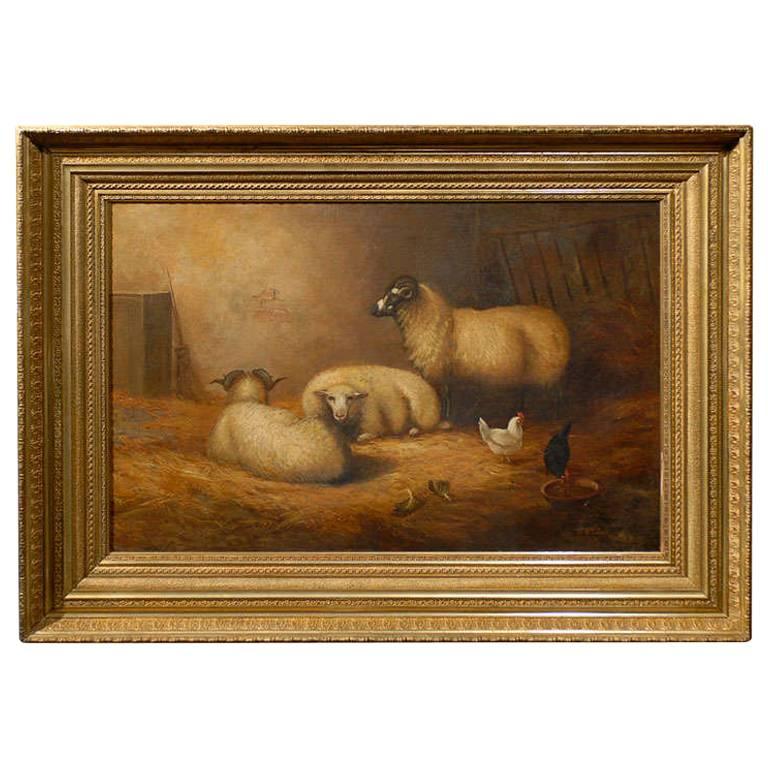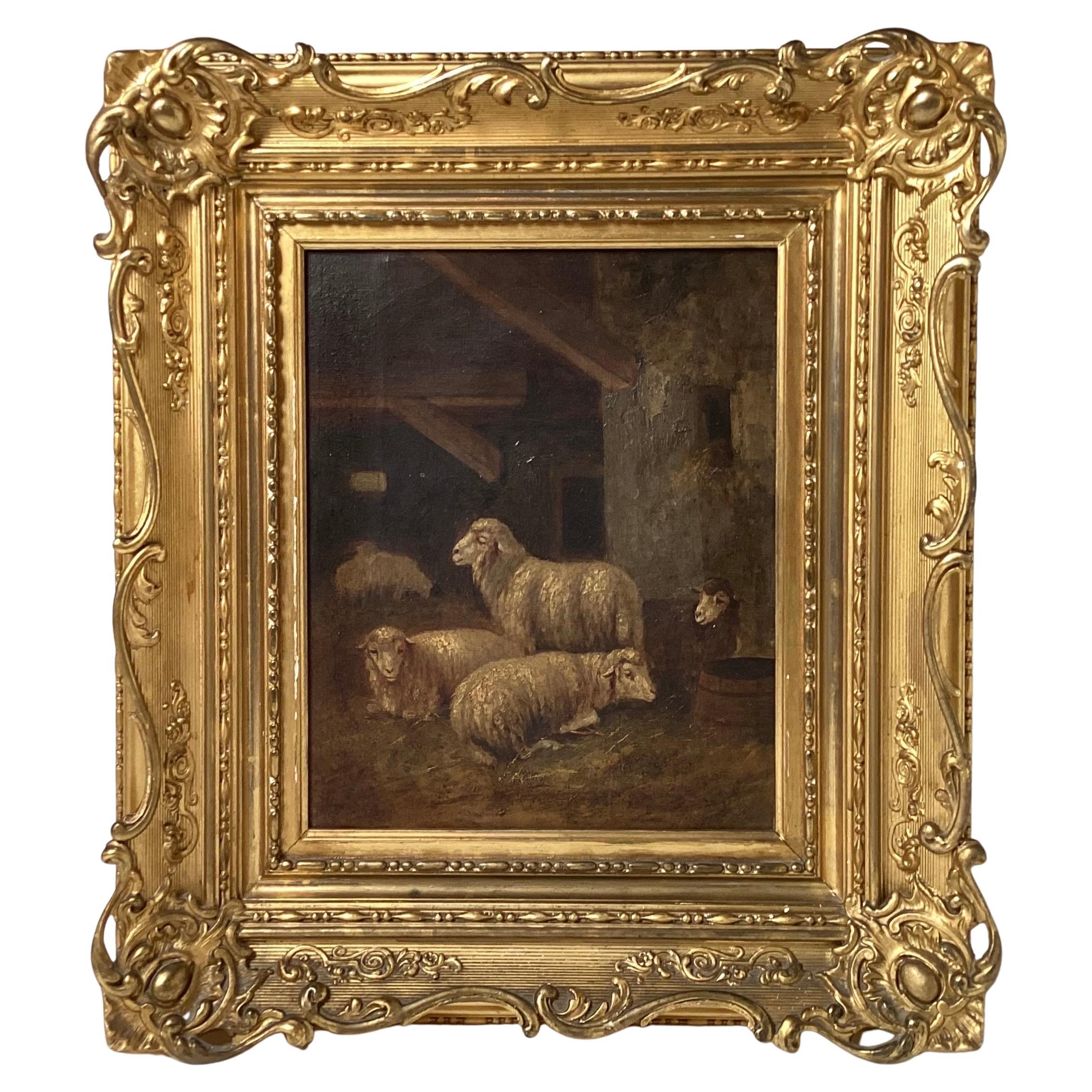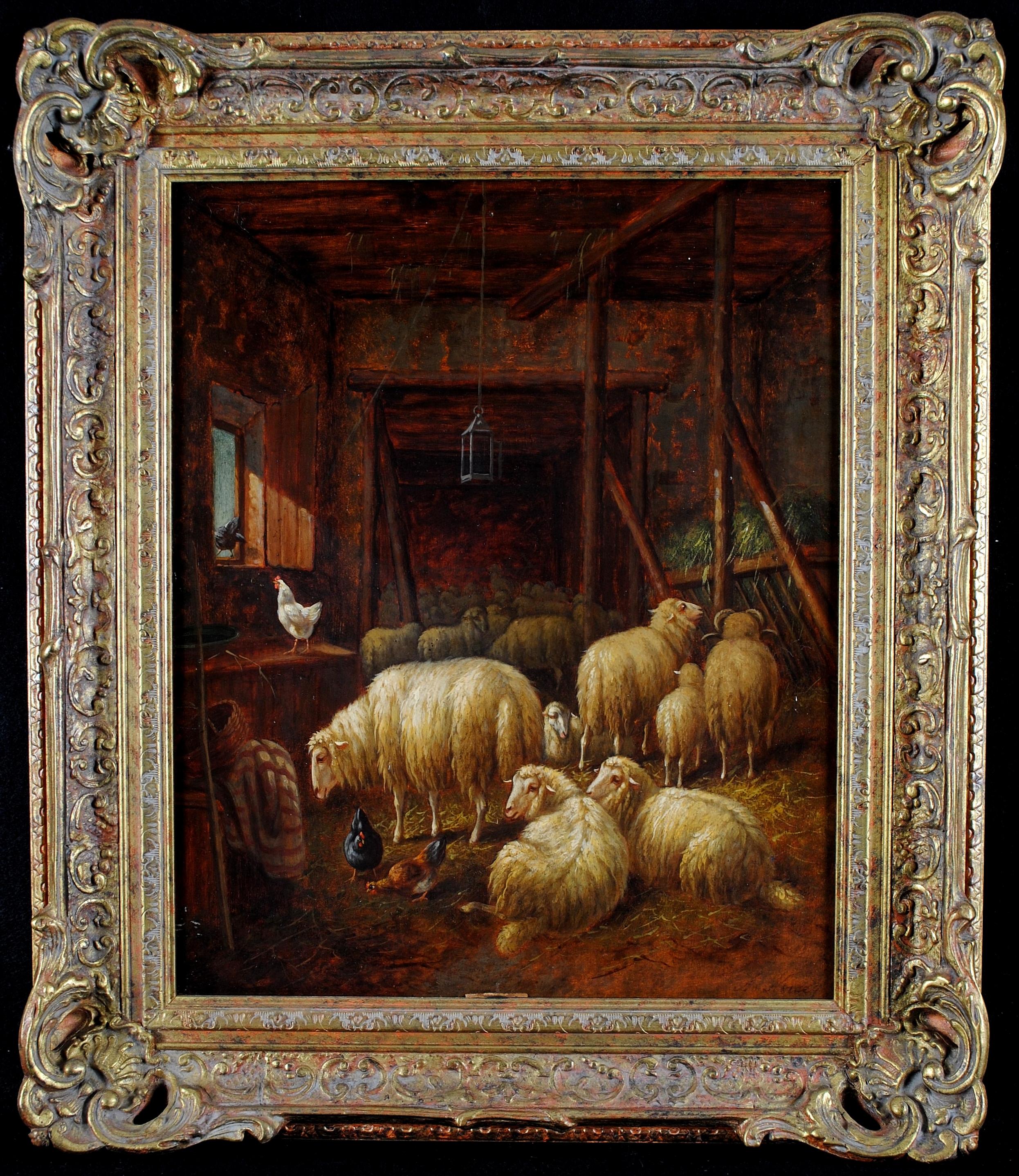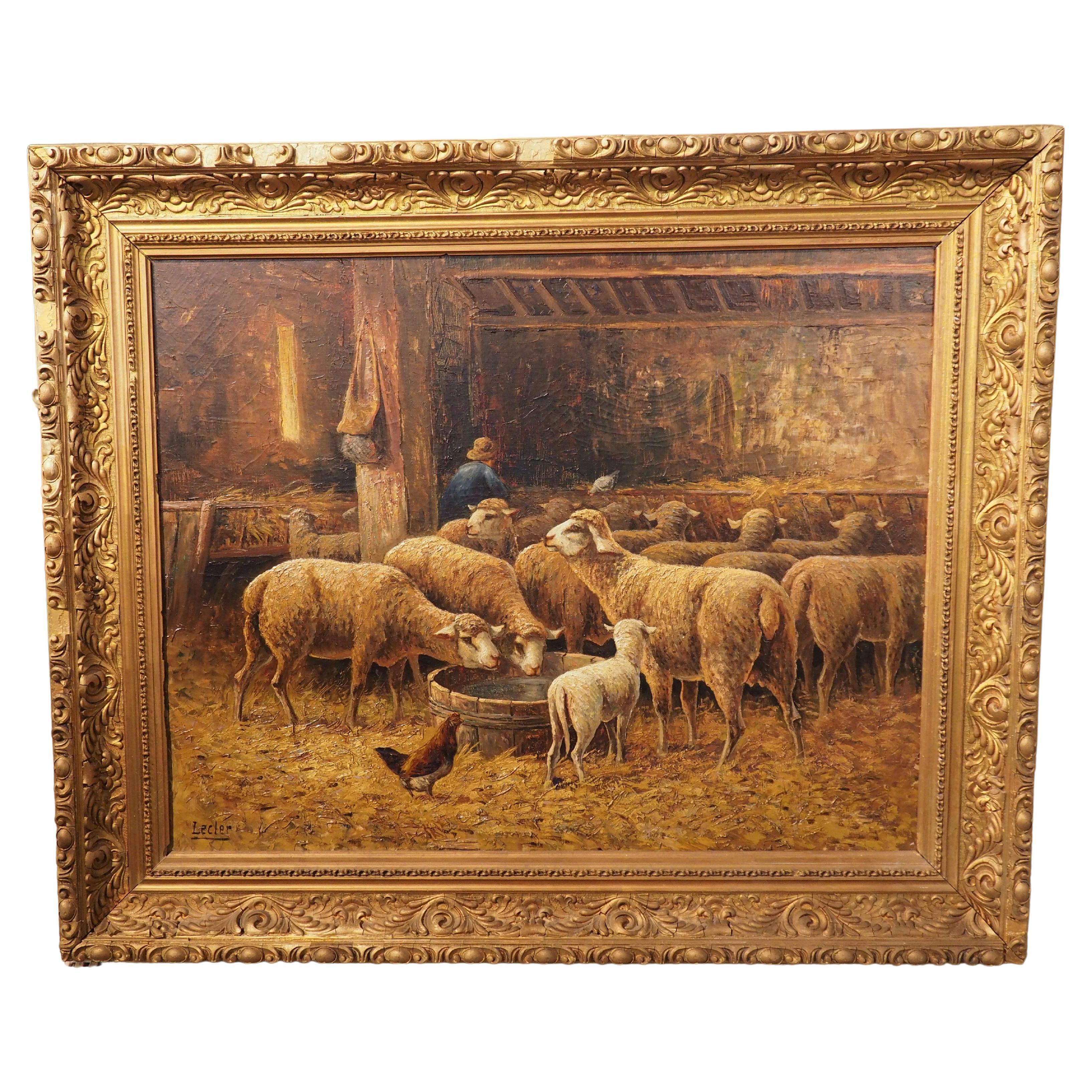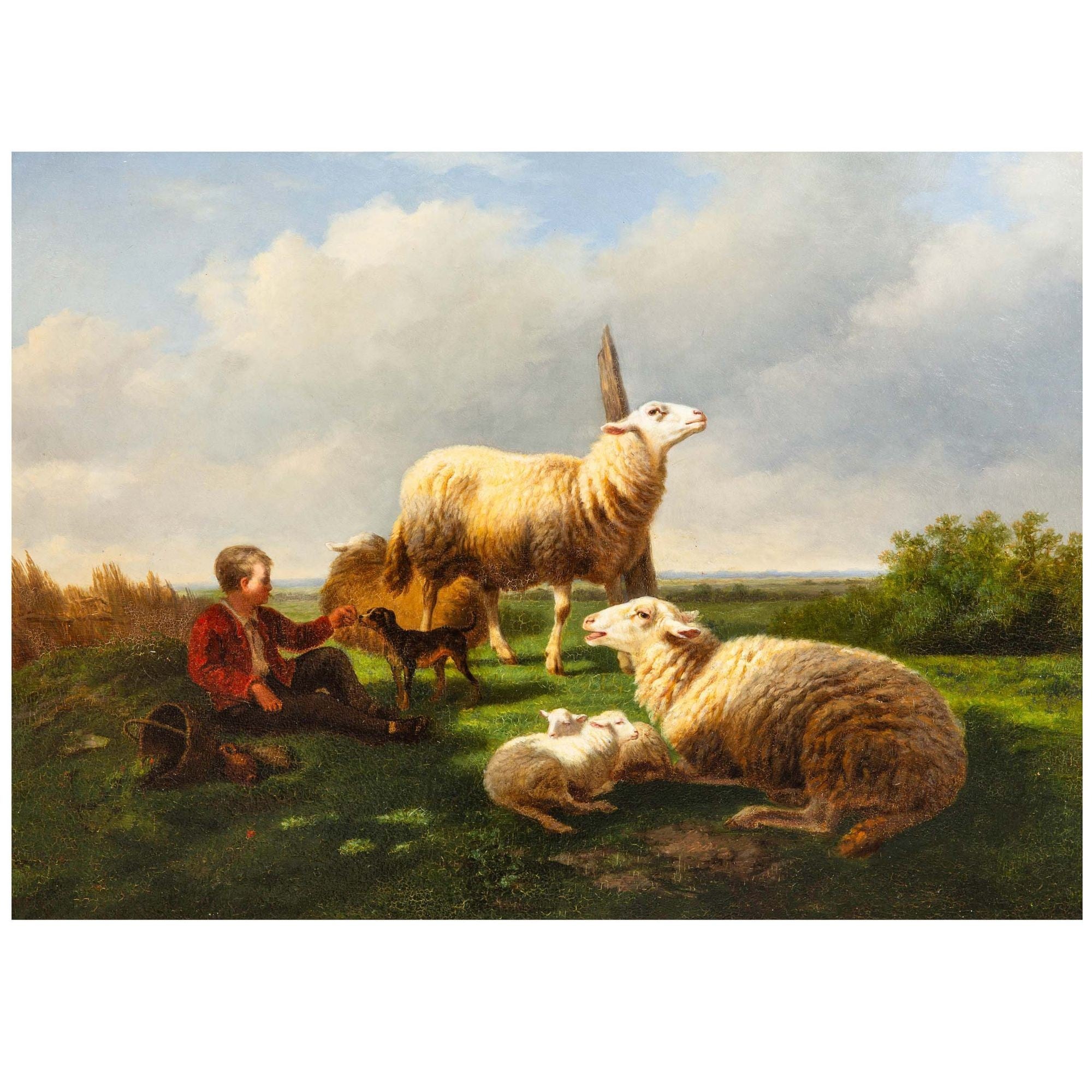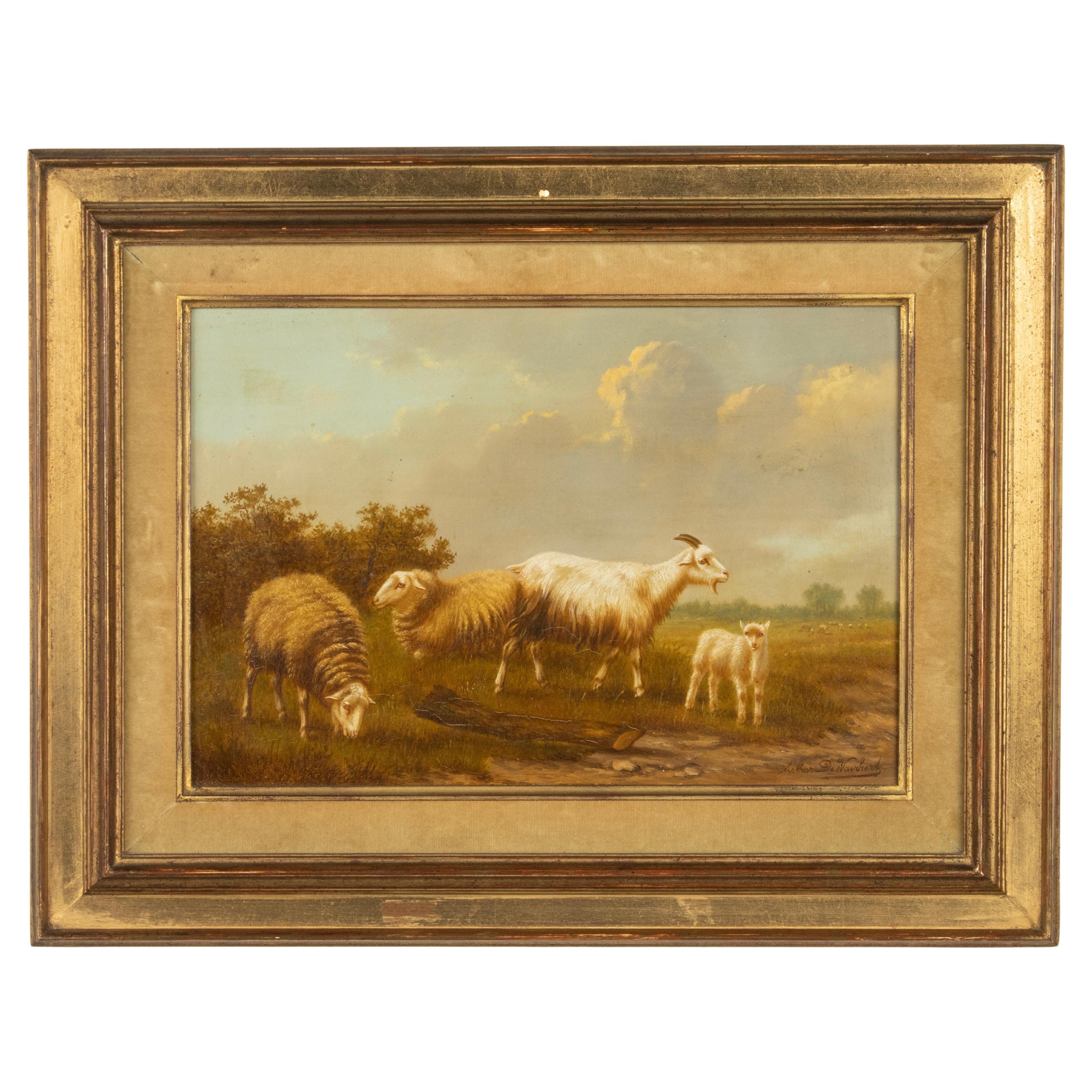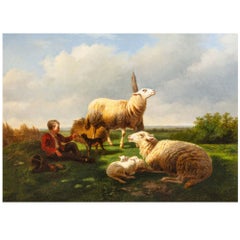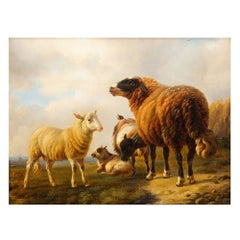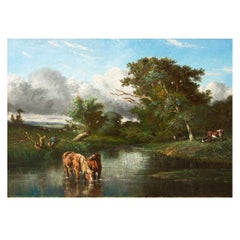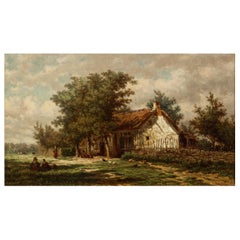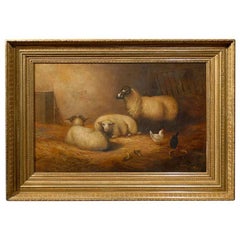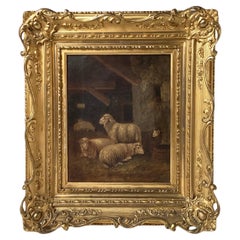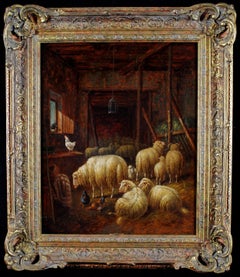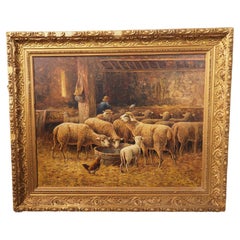Items Similar to French Barbizon Antique Oil Painting of Sheep in Barn by Charles Emile Jacque
Want more images or videos?
Request additional images or videos from the seller
1 of 21
French Barbizon Antique Oil Painting of Sheep in Barn by Charles Emile Jacque
$4,200
£3,206.68
€3,705.29
CA$5,896
A$6,571.71
CHF 3,447.95
MX$80,251.32
NOK 43,658.57
SEK 41,263.98
DKK 27,654.21
About the Item
CHARLES EMILE JACQUE
French, 1813-1894)
Sheep and Chickens in a Stable
Oil on panel signed lower left "Ch. Jacque"
9 3/8" H x 12 15/16" W [panel]
16 3/8" H x 19 7/8" W x 2 3/8" D [frame]
Essay:
A finely composed cheerful pastoral scene by Charles-Émile Jacque, this oil on panel features two sheep standing in a modest barn interior accompanied by several chickens pecking at the straw-covered ground. One sheep gazes calmly at the viewer while the other lowers its head to get a drink of water from the stone trough. Set against a darkened background with hints of a feeding bin with hay captured chaotically within it, the animals are illuminated by a soft, directional light that enhances their texture and volume. Jacque’s characteristic attention to the natural behavior and anatomy of livestock is evident here, with a subdued palette and restrained brushwork that lend the composition a quiet, observational intimacy. The work is signed in the lower left corner in Jacque's typical script.
Condition:
Cleaned by our conservator and re-sealed in traditional Dammar varnish. When examined under UV, the edges show some rubbing from the frame with associated inpainting with flaring varnish in the background that is difficult to read: perhaps some overpainting. Old frame with discoloration, rubbing, chipping and wear as expected. Ready to place.
Biography
Charles-Émile Jacque was one of 19th-century France’s most distinctive artistic voices, bridging fine art and printmaking with a deeply personal vision of rural life. Though closely associated with the Barbizon School, he stood apart for his technical innovation in etching and his quiet focus on animals rather than the human figure. His work helped revive the graphic arts as a respected medium while also capturing the disappearing rhythms of agrarian France.
Born in Paris in 1813, Jacque received no formal academic training. He worked for a notary, apprenticed as a cartographer, and may have decorated chimneys or copied lithographs before turning to art in earnest. Unlike many of his contemporaries, he never attended the École des Beaux-Arts. His only brush with formal instruction came at the Atelier Suisse, an informal studio where artists like Gustave Courbet briefly studied. Military service consumed seven years of his youth, but he continued to sketch and sell small drawings during that time. After his discharge, a stay in London introduced him to British wood engraving, further enriching his technical range.
By the 1840s, Jacque had committed to etching, inspired by Rembrandt and the Dutch masters. He quickly became a central figure in the etching revival, producing hundreds of original prints and joining the Société des Aquafortistes. His early work—depicting military life, satirizing medicine in Parisian journals, and illustrating books—helped him build technical skill and secure a foothold in the art world. He exhibited regularly at the Salon, receiving several third-class medals and praise from critics including Charles Baudelaire.
In 1849, a cholera outbreak drove him to Barbizon, where he joined artists seeking refuge and inspiration in nature. There, he found his lasting subject: the quiet dignity of rural animals. Sheep, pigs, chickens, and ducks became central to his paintings and prints, rendered with careful study and without sentimentality. Unlike peers who focused on laboring peasants, he allowed animals to take center stage. His keen observation extended beyond art; he raised poultry, published articles on agriculture, and even operated a chicken farm. These pursuits reflected a sincere desire to understand the world he depicted.
Though financial hardship marked parts of his career, success came steadily after the 1860s. He received the Légion d’Honneur in 1867 and served on the jury of the Exposition Universelle that same year. Eventually he moved away from Salon exhibitions, selling work directly through dealers. He also turned briefly to furniture design, restoring and fabricating Gothic- and Renaissance-style pieces. In his later years, he adopted a looser painting style and experimented with watercolors. American collectors took notice, and his works entered important collections across the Atlantic.
Jacque died in Paris in 1894, having exhibited for the final time that year. Though long overshadowed by Millet and Rousseau, his legacy has grown. He was not only a master of etching and a sensitive painter of animals, but also a self-taught realist who helped redefine the role of graphic art in modern France. His images endure as quiet testaments to a vanishing countryside, captured with empathy, craft, and a rare fidelity to rural truth.
ref. 412KDQ29P
About silla antiques & art
Established in 2009, we have available in our 9000 square foot brick-and-mortar gallery an ever-changing selection of carefully curated and catalogued furniture, decorative arts, paintings, sculpture and estate jewelry. Our company has long specialized in sculpture circa 1860 through 1930 and as such the gallery always has a very large collection of exceptional European and American sculpture available on display.
The gallery is located at 117 W Burd Street in Shippensburg, Pennsylvania and is open by appointment only. We welcome your visit and would love to meet with you at the shop. For clients located outside of the area, we are always available to discuss items by video conferencing or by phone.
- Creator:Charles Jacques (Artist)
- Dimensions:Height: 16.38 in (41.61 cm)Width: 19.88 in (50.5 cm)Depth: 2.38 in (6.05 cm)
- Style:Barbizon School (Of the Period)
- Materials and Techniques:
- Place of Origin:
- Period:
- Date of Manufacture:Unknown
- Condition:
- Seller Location:Shippensburg, PA
- Reference Number:Seller: 412KDQ29P1stDibs: LU1059044526442
About the Seller
4.9
Recognized Seller
These prestigious sellers are industry leaders and represent the highest echelon for item quality and design.
Platinum Seller
Premium sellers with a 4.7+ rating and 24-hour response times
Established in 2009
1stDibs seller since 2014
512 sales on 1stDibs
Typical response time: 1 hour
- ShippingRetrieving quote...Shipping from: Shippensburg, PA
- Return Policy
Authenticity Guarantee
In the unlikely event there’s an issue with an item’s authenticity, contact us within 1 year for a full refund. DetailsMoney-Back Guarantee
If your item is not as described, is damaged in transit, or does not arrive, contact us within 7 days for a full refund. Details24-Hour Cancellation
You have a 24-hour grace period in which to reconsider your purchase, with no questions asked.Vetted Professional Sellers
Our world-class sellers must adhere to strict standards for service and quality, maintaining the integrity of our listings.Price-Match Guarantee
If you find that a seller listed the same item for a lower price elsewhere, we’ll match it.Trusted Global Delivery
Our best-in-class carrier network provides specialized shipping options worldwide, including custom delivery.More From This Seller
View AllAntique Landscape Oil Painting of Sheep by Lauren de Beul circa 1864
Located in Shippensburg, PA
LAURENT DE BEUL
Belgium, 1821-1872
Shepherd Boy, Dog and Flock in Landscape (1864)
Oil on panel signed with a certifying statement in the artist's hand verso "Je soussigné, déclar...
Category
Antique 19th Century Belgian Romantic Paintings
Materials
Paint
Antique Landscape “Sheep and Goats” by Eugene Verboeckhoven circa 1859
By Eugène Verboeckhoven
Located in Shippensburg, PA
A finely detailed bucolic landscape capturing two sheep in the foreground and a pair of goats just behind them on a pasture of green grasses with golden billows of wheat in the background. In the distance we see hints of a windmill at the unusually low horizon beneath brilliant bright skies. The work is signed in his typical manner lower left.
ARTIST
Read about the life of Eugene Verboeckhoven...
Category
Antique 19th Century Belgian Romantic Paintings
Materials
Paint
French Barbizon Pastoral Landscape Painting of Horses by Jules Dupré
By Jules Dupré
Located in Shippensburg, PA
A fine example of Dupré's work from the 1840s from the period while he was still operating under the distinct influence of John Constable, the spacial orientation is roughly divided ...
Category
Antique 19th Century French Barbizon School Paintings
Materials
Canvas, Paint
Barbizon Landscape Painting by Jan van Lokhorst "A Rural Cottage" (1867)
By Jan van Lokhorst
Located in Shippensburg, PA
A wonderful Barbizon influenced landscape painting by Johan Nicolaus Lokhorst, who generally went by Jan van Lokhorst and signed much of his work as s...
Category
Antique 19th Century Dutch Barbizon School Paintings
Materials
Paint
Rare Landscape Painting of Shepherds and Injured Lamb by Hermann Corrodi
By Hermann Corrodi
Located in Shippensburg, PA
HERMANN DAVID SALOMON CORRODI
Italian, 1844-1905
Bucolic Landscape of Shepherds Caring for an Injured Lamb (1868)
Oil on canvas signed lower left "H. Corrodi Roma 68"
Item # C104...
Category
Antique 19th Century Italian Romantic Paintings
Materials
Canvas, Wood, Paint
French Barbizon Antique 19th Century Oil Landcape River Painting
Located in Shippensburg, PA
FRENCH BARBIZON
19th century
Women Washing Clothing by the River's Edge at Golden Hour
18 3/8" H x 30 7/8" W [frame]
14 3/8" H x 26 7/8" W [canvas]
A wonderfully rendered late 19t...
Category
Antique 19th Century French Barbizon School Paintings
Materials
Canvas, Paint
You May Also Like
Large English 1880s Painting Depicting Sheep and Chickens in a Barn by W. Topham
By Topham
Located in Atlanta, GA
A large English oil painting depicting three sheep in a barn with chickens from the late 19th century, signed W. Topham and set in a giltwoo...
Category
Antique Late 19th Century English Paintings
Materials
Canvas, Paint
19th Century Continental School Oil on Canvas of Sheep in a Barn
Located in Lambertville, NJ
A European Continental School oil on canvas in elaborate original gilt and gesso frame. The painting depicts sheep in their barn in a calming and serine position. The elegant origina...
Category
Antique 19th Century European Paintings
Materials
Canvas, Giltwood
Sheep in a Barn - 19th Century Antique English Chickens Animal Oil Painting
Located in Sevenoaks, GB
A beautiful late 19th century English oil on panel depicting sheep and chickens in a n old barn.
Excellent quality work in superb original condition, presented in a good quality swe...
Category
Late 19th Century Animal Paintings
Materials
Oil, Panel
19th Century French Oil on Canvas Painting, "In the Sheepfold", Signed Lecler
Located in Dallas, TX
Signed by the artist in the lower left corner (“Lecler”), this oil on canvas painting is entitled In the Sheepfold. A typical day in the life of a farmer dressed in blue with a gold hat, the agriculteur can be seen tending to a hay feeder. Behind the man is a flock of 15 sheep, mostly depicted with tan wool and white faces and ears, with the exception of a small all-white lamb. Some of the livestock is grazing from the feeders, while four of them (including the lamb) are gathered near a large water trough. A pair of chickens can be spotted amongst the herd, including a brown rooster...
Category
Antique 19th Century French French Provincial Paintings
Materials
Canvas, Wood, Giltwood, Paint
Early 20th Century Oil Painting on Panel - Sheep in Field - Arthur de Waerhert
By Arthur de Waerhert
Located in Casteren, Noord-Brabant
A sweet antique painting, oil on oak panel, depicting sheep in the field.
It is a painting by the famous Flemish artist Arthur de Waerhert. He lived from 1881 to 1944 and mainly pai...
Category
Vintage 1910s Belgian Belle Époque Paintings
Materials
Wood
Large Early 20th Century Oil on Canvas Painting of Sheep by Charles T. Phelan
By Charles T. Phelan
Located in Middleburg, VA
Large early 20th century oil on canvas painting by New York artist Charles T. Phelan depicting a flock of sheep in a landscape at dusk. Signed and dated 1902 in lower left corner. Pr...
Category
Early 20th Century American Paintings
Materials
Canvas, Paint
$4,104 Sale Price
52% Off
More Ways To Browse
French Renaissance Painting
French Military Paintings
Pig Jewelry
Wood Pig Sculpture
Stone Pig
Chicken Jewelry
Antique Drinking Trough
Feed Trough
Antique Feeding Trough
19th Century American Trough
Pig Trough
Caste Furniture
Ceramic And Fiber Wall Sculpture
Chinese Export Silver Tea Set
Chinese Lattice Panel
Chinese Pottery Statue
Coffee Pot Enamel
Commode Desk Antique
